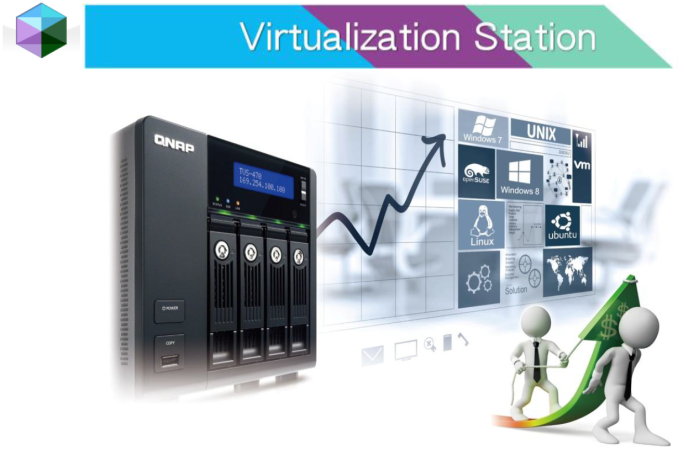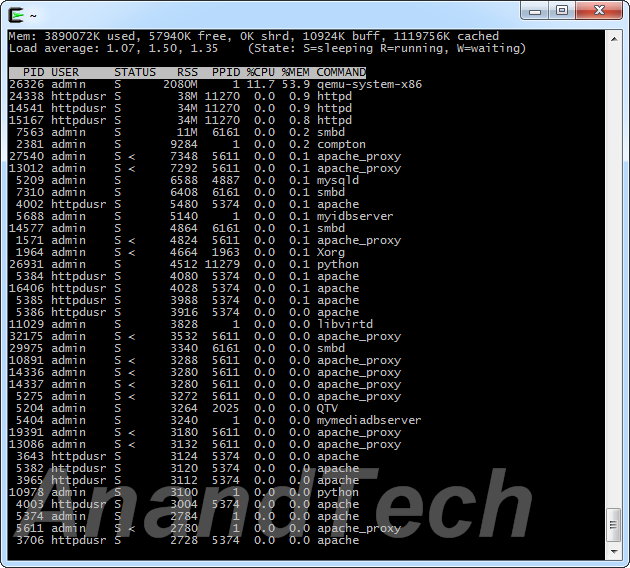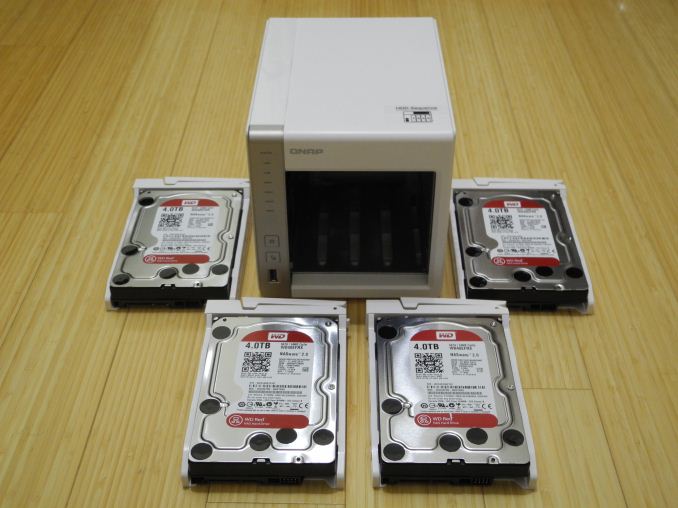NAS Units as VM Hosts: QNAP's Virtualization Station Explored
by Ganesh T S on August 18, 2014 10:15 AM EST- Posted in
- NAS
- Storage
- Virtualization
- QNAP

Introduction
Virtualization Platforms - A Brief Background
Virtualization has been around since the 1960s, but it wasn't till Intel and AMD started introducing hardware acceleration features that the feature started gaining mainstream focus outside enterprise applications. In addition to several applications in the enterprise space, virtualization has also started to lower the cost of IT infrastructure even for SMBs (think in terms of virtualized Exchange servers and similar applications). However, does the current state of virtualization offer any applications / benefits to home users? What are the ways in which regular users can take advantage of it? The answer to the second question is partly provided by QNAP's Virtualization Station package in the TS-x51 series. The answer to the first question will decide whether the Virtualization Station package can offer compelling enough benefits for users to choose the QNAP TS-x51 series over competing models from other vendors.
Put simply, the virtualization concept that we are discussing today refers to the creation of computing resources that exist 'virtually' - i.e, independent of the underlying hardware infrastructure. Most commonly, the creation of a virtual machine (VM) implies the setting up of a computer (guest machine) on certain hardware resources (host machine) such that the software / OS being run on the VM is separated from the host's hardware resources. An example could be the setting up of a Linux distribution as a VM on a computer running Windows as the host OS. Software developed for Linux can be run on the VM. The combination of hardware and software on the host machine which enables the creation and running of VMs is called as the hypervisor.
Hypervisors come in two flavours: bare-metal and hosted. While bare-metal solutions install directly on the hardware (VMware ESXi, Citrix XenServer and Microsoft Hyper-V), hosted ones run on top of a host OS. As examples of the latter, we have Oracle VM VirtualBox, QEMU and Hyper-V for Windows. QNAP's Virtualization Station is also a hosted hypervisor. It is based on QEMU (determined by taking a look at the running processes in the QNAP TS-451 with a VM active). We have already looked at the performance aspects of the TS-451 in an earlier review.
QEMU powers almost all of the Linux-based virtualization technologies. It takes advantage of the hardware-level support in processors (an additional reason why QNAP's Virtualization Station is supported only on models with CPUs supporting VT-x capabilities).
Readers interested in learning more about virtualization (particularly from a SMB / SME viewpoint) can peruse our articles focused on that market segment. In the rest of this write-up, we will take a detailed look at QNAP's Virtualization Station, followed by a hands-on report of how it works in the TS-451. One of the unique features of QTS 4.x is the support for SMB 3.0. We take this opportunity to evaluate SMB 3.0 support in the process of determining the performance impact of running a VM on the TS-451. We will also talk about power consumption numbers in the concluding section. Prior to all that, we take a look at the testbed infrastructure for evaluating performance as well as long term usage.
Performance Evaluation Setup
The QNAP TS-451 can take up to four drives. The benchmarks presented later in this review are with the unit configured in RAID 5 using four Western Digital WD4000FYYZ RE drives as the test disks.
| AnandTech NAS Testbed Configuration | |
| Motherboard | Asus Z9PE-D8 WS Dual LGA2011 SSI-EEB |
| CPU | 2 x Intel Xeon E5-2630L |
| Coolers | 2 x Dynatron R17 |
| Memory | G.Skill RipjawsZ F3-12800CL10Q2-64GBZL (8x8GB) CAS 10-10-10-30 |
| OS Drive | OCZ Technology Vertex 4 128GB |
| Secondary Drive | OCZ Technology Vertex 4 128GB |
| Tertiary Drive | OCZ Z-Drive R4 CM88 (1.6TB PCIe SSD) |
| Other Drives | 12 x OCZ Technology Vertex 4 64GB (Offline in the Host OS) |
| Network Cards | 6 x Intel ESA I-340 Quad-GbE Port Network Adapter |
| Chassis | SilverStoneTek Raven RV03 |
| PSU | SilverStoneTek Strider Plus Gold Evolution 850W |
| OS | Windows Server 2008 R2 |
| Network Switch | Netgear ProSafe GSM7352S-200 |
The two ports of the TS-451 were link aggregated in 802.3ad LACP to create a 2 Gbps link for the cases in which no VM was active. In the active VM case, one of the network ports gets dedicated to the VM, while the other is reserved for NAS use. Our performance evaluation testbed configuration is outlined above.
Long Term Evaluation Setup
Usage of WD Re drives and Netgear's GSM 7352S switch make sense for benchmarking purposes, but hardly reflect the general use-case of the QNAP TS-451.
In order to simulate day to day usage, we utilized four WD Red hard drives in a RAID-5 configuration. The performance, as expected, doesn't scale up to what can be obtained with the Re drives, but that is hardly required for most applications of the TS-451.
Thank You!
We thank the following companies for helping us out with our NAS testbed:
- Thanks to Intel for the Xeon E5-2630L CPUs and the ESA I-340 quad port network adapters
- Thanks to Asus for the Z9PE-D8 WS dual LGA 2011 workstation motherboard
- Thanks to Dynatron for the R17 coolers
- Thanks to G.Skill for the RipjawsZ 64GB DDR3 DRAM kit
- Thanks to OCZ Technology for the two 128GB Vertex 4 SSDs, twelve 64GB Vertex 4 SSDs and the OCZ Z-Drive R4 CM88
- Thanks to SilverStone for the Raven RV03 chassis and the 850W Strider Gold Evolution PSU
- Thanks to Netgear for the ProSafe GSM7352S-200 L3 48-port Gigabit Switch with 10 GbE capabilities.
- Thanks to Western Digital for the four WD Re hard drives (WD4000FYYZ) and four WD Red hard drives (WD40EFRX) to use in the NAS under test.












38 Comments
View All Comments
DanNeely - Monday, August 18, 2014 - link
Could you add the power level with the NAS idle and no VM running to the table on the last page of the article?ganeshts - Monday, August 18, 2014 - link
I have updated the article with the latest power numbers.iAPX - Monday, August 18, 2014 - link
It's not a NAS, it's a server that host up to 4-drives, and is clearly not targeted at data centers.Too expensive for SOHO, and anyway not good as a Virtualization platform (4GB or 8GB RAM max is really ridiculous to aggregate many little servers into a box), nor good as a NAS for enterprise (due to the encryption bandwidth cap), and worse when doing both of them (no more bandwidth aggregation!).
I wonder where is the market for such an hybrid, when I will instead use a simpler less expansive NAS on one side, and a dedicated VM server on the other (many cores and 32GB+ RAM) ?!?
ganeshts - Monday, August 18, 2014 - link
The target market is home users (power users / enthusiasts). Note that I haven't talked about the unit's transcoding capabilities (I mentioned it in the first review). QTS is a popular COTS NAS OS.I do agree on the expensiveness part - but, most other COTS NAS are in the same price range. QNAP is demanding a slight premium because of the virtualization and extensive transcoding features which no other COTS NAS has, as of now.
Btw, this unit has the capability to run only 1 VM. If you want multiple servers in a 'box', then, the higher end solutions such as the TS-EC1279U-RP are your best bet.
QNAP doesn't expect the TS-451 to be used as an Exchange server. The four use cases are meant for the rackmount units mostly.
I have already covered why the combo concept could be a better bet in many circumstances - data traffic doesn't clog up the network, power consumption with one physical machine is better than two. Again, it depends on how many VMs you want to run at the same time. The TS-451 is suitable for home use.
iAPX - Monday, August 18, 2014 - link
I understand your point, but in this case, a simpler NAS, with one or two Intel NUC wouldn't be better (and load-balanced to be crash-prone) ?And anyway more expandable, on the VM side, both in available CPU, RAM, or by adding simple inexpensive units?
ganeshts - Monday, August 18, 2014 - link
Taken standalone (just talking about virtualization features), you are definitely right about what provides more flexibility.However, when people look at the TS-451 as an 'appliance', they see the virtualization aspect as just one of the features. Transcoding is another major aspect (and put in all the myriad QTS applications like QSync, cloud access etc.). The whole is greater than the sum of the parts.
iAPX - Monday, August 18, 2014 - link
I don't buy it, because to use all of that you need to be a linux sysadmin wannabee, to install and run Linux VM (at least, or BSD, or ...). At this point you might be able to control your own set of dedicated servers.Anyway, I appreciated your follow-up to this article, and your point-of-view, it's great to have this level of commitment, and to be able to have insights when there's remaining questions. Kind regards.
ganeshts - Monday, August 18, 2014 - link
I am not sure I follow the 'linux sysadmin wannabee' aspect. You can install any type of VM you want - Windows or Linux or even Android.Transcoding - This is plug and play. After installing the NAS, accessing the video files in it through QNAP's mobile app - Qfile - can trigger the transcoding depending on what quality level is chosen. This is orthogonal to the VM feature. You don't need any VMs running to use the transcoding feature.
All QTS apps - These provide additional features and are again not depending on the VM aspect.
I fear I might not have effectively conveyed my points across.
bsd228 - Monday, August 18, 2014 - link
you'd need to be that sysadmin wannabee to deploy the NUC solution you suggest as well.iAPX - Monday, August 18, 2014 - link
Exactly, in both case you might need to be a sysadmin (even a wannabe! lol!), wether it's windows or linux doesn't count, as Ganesh stated, but if you know hot to install and handle a VM with an OS, and remote access it correctly, you have it needs to handle Intel NUC (or whatever is your VM host of choice), and don't need a box that will make it easier to handle different services.In fact I think there's a much more larger market for a NAS that don't have virtualization, (thus a less expensive tag price, and lighter CPU/RAM configuration) but provides these services through "bundles" or "plug-in" (whatever you call them) hosted on their main Linux OS.